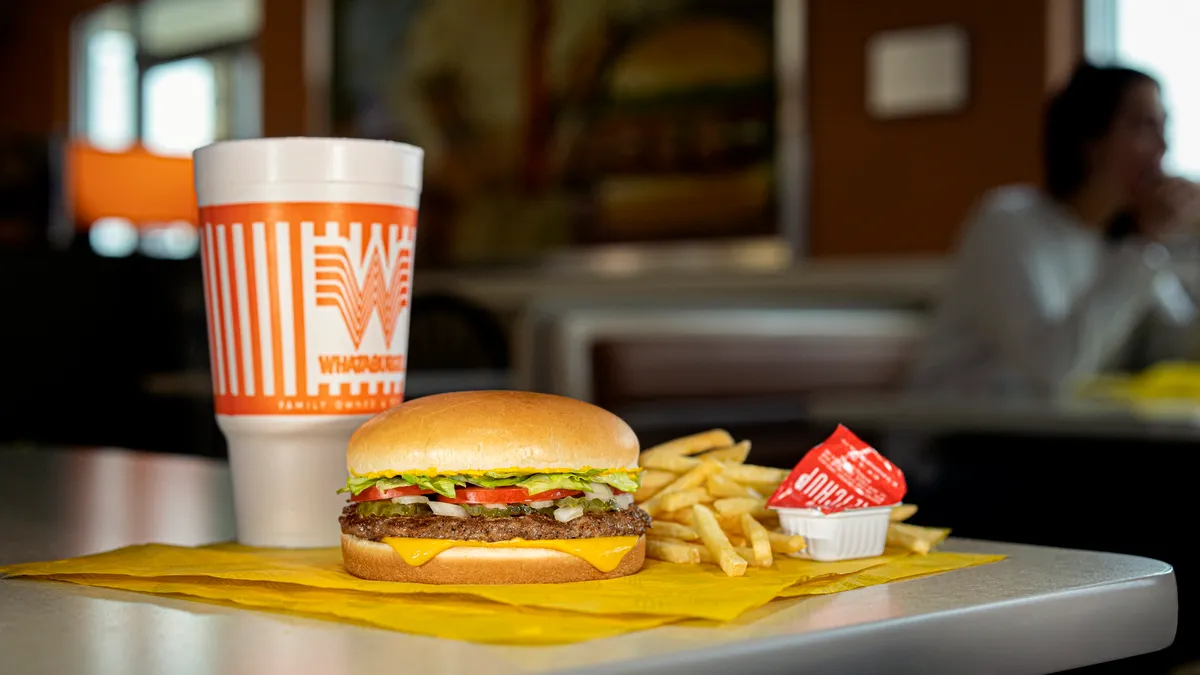Editor’s Note: This story has been updated with further comment from Whataburger.
Dive Brief:
- Whataburger is shifting its rewards program to a bankable points system, offering customers 10 points for every $1 spent online and in store and expanding the variety of menu items customers can redeem with points, the chain announced Wednesday.
- Similar to a coffee shop punchcard, Whataburger’s previous rewards app granted users a free reward for every five visits when it launched in 2016. Those rewards were limited to a small selection of menu items.
- Several restaurant brands have adopted bankable loyalty points programs in recent years alongside flashy assets including gamified features to rewards tiers.
Dive Insight:
Whataburger tested its new program in core and growth markets and received positive customer feedback, prior to rolling the system out on Feb. 14. The rewards program works at the vast majority of restaurants, the company told Restaurant Dive, with the notable exception of airport and stadium locations.
While it’s common for restaurants to frame changes to their rewards programs as improvements for members, such alterations often lower effective discounting rates. Whataburger did not clarify any changes to its effective discount rate.
It is possible, however, to calculate Whataburger’s current effective discount rate. Restaurant Dive analyzed menu pricing at an Atlanta-area Whataburger and rewards points values, which are visible to rewards members, to calculate a general discount rate. For consistency, Restaurant Dive compared the discount rates of the least expensive and most expensive items in terms of points, as well as the chain’s signature Whataburger.
So, how much are Whataburger rewards worth? A comparison of menu prices with rewards point costs reveals a general discount rate between 5.8% and 8.3%, though it’s possible that there are discount rates outside of this range depending on the price of individual items at different locations.
In interviews for a previous story on Dunkin’s loyalty program, Kristin Lynch, director of strategy and data at Paytronix, said her company generally keeps their discount rate on core products between 6% and 10%, preferably below 8%, to offer customers value but constrain the impact of discounting on margins. Chains like Dunkin’ and Starbucks have rebalanced their point systems in recent years, adding new items, increasing discount rates for select products and cutting discount rates for core menu items.
At Dunkin’, the decision to increase the points price of most coffee drinks reduced the discount customers received on beverages. The chain added food items to its redemption scheme for the first time and increased the number of points earned per $1. But the price changes to drinks effectively devalued points. Dunkin’s changes cut the discount on frozen coffees from about 13% to just shy of 6%. These changes angered longtime rewards members who used the chain’s program primarily to buy coffees. Such changes can pose reputational risks for chains with a strong sense of customer loyalty based on a small number of core products.
To promote the new rewards model, Whataburger is automatically adding 500 points — enough to redeem various breakfast sandwiches — to its roughly 3 million active loyalty member accounts. Whataburger will award 1,000 points to new users when they sign up, the company said in an email to Restaurant Dive. Rewards can be redeemed online or in store, and expire after one year, according to the chain’s website. Whataburger changed its model following customer feedback indicating rewards members wanted to access more discounted menu items.
Whataburger operates about 900 restaurants in 14 states and recently appointed Debbie Stroud, a former Starbucks and McDonald’s executive, as chief operating officer.












